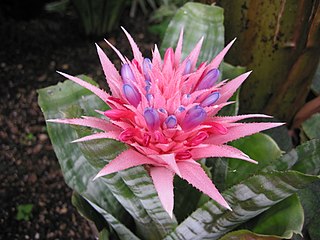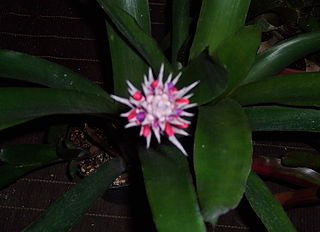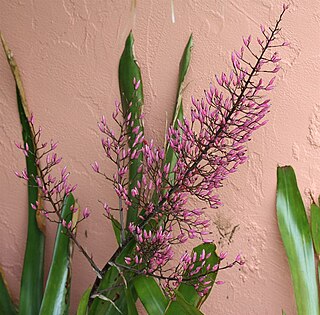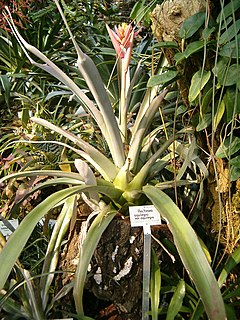
Aechmea is a genus of flowering plants in the family Bromeliaceae. The name comes from the Greek aichme, meaning "spear". Aechmea comprises eight subgenera and around 250 species distributed from Mexico through South America and the Caribbean. Most of the species in this genus are epiphytes.

Aechmea chantinii is a bromeliad native to the Amazon Rainforest vegetation in Brazil, Venezuela, Colombia, Ecuador and Peru. Commonly known as Amazonian zebra plant, it is often used as an ornamental plant.

Aechmea fasciata is a species of flowering plant in the Bromeliaceae family. It is commonly called the silver vase or urn plant and is native to Brazil. This plant is probably the best known species in this genus, and it is often grown as a houseplant in temperate areas.

Aechmea dealbata is a bromeliad in the subfamily Bromelioideae. This plant species has spiny green foliage with a complex pink and purple inflorescence. It is epiphytic but will grow in soil and is commonly cultivated. This species is endemic to the State of Rio de Janeiro in Brazil.

Aechmea mulfordii, the living vase bromelia, is native to the states of Pernambuco and Bahia in eastern Brazil. Most of the other plants in this genus are epiphytic, which means that they live up in the branches of the trees and exist mainly on the moisture and nutrients they obtain from the air. However, Aechmea mulfordii is a large terrestrial plant, growing near the sea level on sand dunes.

Aechmea spectabilis is a plant species in the genus Aechmea. This species is native to Venezuela and Colombia.

Aechmea calyculata is a species of flowering plant in the Bromeliaceae family.

Aechmea aquilega is a plant species in the genus Aechmea. This species is native to Brazil, Venezuela, the Guianas, Trinidad, Jamaica and Costa Rica.

Aechmea comata is a species of flowering plant in the Bromeliaceae family. This species is endemic to southern Brazil.

Aechmea weilbachii is a plant species in the genus Aechmea. This species is endemic to eastern Brazil, known from the States of Espírito Santo and Rio de Janeiro.

Aechmea caudata is a species in the genus Aechmea. This species is native to southeastern Brazil from Espírito Santo to Rio Grande do Sul.

Aechmea recurvata is a plant species in the genus Aechmea. This species is native to southern Brazil, Paraguay, Uruguay and northern Argentina.
Aechmea cucullata is a plant species in the genus Aechmea. This species is native to Colombia and Ecuador.

Aechmea nidularioides is a plant species in the genus Aechmea. This species is native to Colombia, Ecuador, and Peru.

Aechmea retusa is a plant species in the genus Aechmea. This species is native to Ecuador, Colombia and Peru.

Aechmea dichlamydea is a species of bromeliad in the genus Aechmea. This species is native to Venezuela and to Trinidad and Tobago.

Aechmea tocantina is a species of flowering plant in the Bromeliaceae family. This species is native to northern and central South America.

Aechmea rubens is a plant species in the genus Aechmea. It was described from specimens cultivated in the Jardin Botanique de Montréal, supposedly grown from Brazilian material. Exactly place of origin unknown, and the species has not been located in the wild.

Aechmea smithiorum is a plant species in the genus Aechmea. It is a medium-sized bromeliad with broad green leaves and a striking white rosette.

















